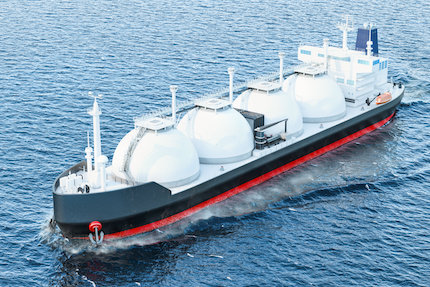Europe had already been suffering from low supplies of natural gas this winter, accompanied by higher costs as demand outpaced supply. But now, the invasion of Ukraine by Russia (which had until very recently supplied more than 40% of Europe’s gas imports) has triggered further price increases.
With Russian gas out of the picture, European gas prices are soaring. On March 4, European wholesale prices for next-day delivery soared 38% in one day, to nearly $225 per megawatt hour—a ninefold increase compared with a year ago!

One solution to Europe’s gas woes is to fill the loss of natural gas supply coming from Russia’s Gazprom with liquified natural gas (LNG) from the United States. In fact, Europe has been the top destination for U.S. LNG for the past four months in a row.
And while Europe’s LNG import facilities need to be expanded, Europe’s need for natural gas is truly good news for some American companies, such as Cheniere Energy (LNG).
Cheniere Energy: A Growth Business
Cheniere, which began operations in 2016, is the largest producer of LNG in the United States and the second-largest LNG operator in the world. It sells its LNG in more than 40 countries (expected to be 60 countries within a few years) on five continents.
Wall Street—the home of short-term thinking—has had Cheniere Energy in its doghouse for many years, trading in the $50 to $60 range. Traders seem not to have liked the fact that Cheniere was spending several billion dollars a year building LNG export terminals with virtually no immediate revenue. There were doubts that anyone wanted U.S. gas.
Fast forward to 2022 and Cheniere’s business is booming. In its latest earnings conference call, the company said it expected to hit at least $7 billion in operating profits this year. And the company has enough cash flow to begin paying down its $30 billion debt load, as well as start a dividend.
Make no mistake: this is a growth business.
The U.S. began LNG exports just five years ago. The Department of Energy predicts that it will soon have the largest peak export capacity of any nation in the world, going from 11.6 billions of cubic feet per day to 16.3 Bcf/d by the end of 2024.
Cheniere itself already has the capacity to export 45 million tons annually of LNG. And it’s adding more capacity—about 10 million more tons.
Cheniere’s Global Ambitions
Europe will be an eager buyer. Even before the Ukraine war, according to an analysis by consultancy Wood Mackenzie, European benchmark gas futures were trading at around $30 per million British thermal units. Even factoring in transport costs, U.S. LNG is priced at roughly $10 per million BTU.
And of course, there is the traditional large buyer of LNG: Asia.
Last October, Cheniere’s chief commercial officer, Anatol Feygin, told the Financial Times that Asian demand for natural gas is set to drive growth in the LNG industry for “decades to come.” He said the company expected to approve a $7 billion expansion to its liquefied natural gas facility in Texas in 2022 to meet surging demand for LNG cargoes in Asia, led by China.
Feygin went on to say: “The infrastructure commitment that China is making from a capital investment, but also from a policy and regulatory standpoint to gas, is very substantial. He added that Chinese demand alone had the potential to “double” Cheniere’s business.
Cheniere signed the first ever long-term contract to supply American LNG to China in 2018. In October, Cheniere signed its second long-term Chinese supply contract—a 13-year agreement with a subsidiary of China’s ENN Natural Gas.
Cheniere’s Bright Future
There’s a lot to like about Cheniere Energy at the moment…
First, Cheniere has some of the lowest-cost LNG projects in the world—around $500 to $600 per ton, well below the U.S. average of $800 per ton.
The company has some good lawyers, too: its contracts have neither price re-openers nor linkage to oil prices, and flexibility on where the LNG can be delivered. In effect, it’s a toll business with secure revenues coming in.
I believe Cheniere will have billions of dollars to deploy over the next few years. This can be used for expansion, debt reduction and more stock repurchases, as well as higher dividends.
Finally, with the Russia-Ukraine situation, U.S. LNG is beginning to enjoy more of a market view as a
reliable supplier of natural gas. This will boost the largest exporter of LNG in the United States, making Cheniere Energy the biggest winner in this whole sad situation.
The stock is a buy on any weakness intraday anywhere in its current range around $140 a share.





